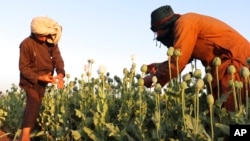Unlike his predecessor, who almost terminated opium production in Afghanistan in the last year of Taliban rule with one decree in 2000, the current supreme leader of the Taliban appears to be unsuccessful in implementing his ban on opium production.
In April, shortly after Afghan famers harvested opium from their 2021 poppy cultivation, Hibatullah Akhundzada issued a decree outlawing poppy cultivation and the production, sale and use of all other drugs.
As this year's poppy cultivation season approaches, the Taliban have presented a modest scorecard for their counternarcotics achievements.
Over the past year, less than 100 hectares of poppy fields were destroyed, about 2,000 drug dealers and traffickers were arrested, and 4,270 kilograms of opium were seized, according to figures from the Taliban's Interior Ministry.
These figures put the Taliban regime far behind the previous Afghan government, which presided over two decades of soaring drug production in Afghanistan, in counternarcotics performance.
In 2020, the Afghan government made more than 3,100 drug-related arrests, seized about 80,000 kilograms of opium and eradicated almost 1,000 hectares of poppy fields, according to the U.N. and Afghan officials.
"There is serious doubt on the intentions of the current rulers whether they really want to eradicate poppy," said Javid Qaem, a former deputy minister for counternarcotics in Afghanistan and now a researcher at Arizona State University.
"At the time of the Republic, security was a big challenge. Police could not go to the areas where poppy was cultivated. Taliban claim that they have all the areas under their control. They should be able to do it easily," he told VOA.
The U.N. Office on Drugs and Crime (UNODC) has yet to release its annual assessment of the Afghan opium production for 2022 but says the trend appears unchanged.
"Although the peace process in Colombia and the Taliban's return to power in Afghanistan have essentially ended insurgencies, both countries have to date retained prominent roles in illicit drug cultivation and production," the UNODC reported in June.
Economic considerations?
Income from opium production, estimated between $1.8 billion to $2.7 billion, made up about 12% to 14% of Afghanistan's GDP in 2021.
With the Taliban's return to power, Afghanistan has plunged deep into an economic crisis that has pushed nearly all Afghans into poverty. The U.N. says more than half of the Afghan population is in need of urgent humanitarian assistance.
"Drugs have been a critical source of economic revenue in this impoverished country," Vanda Felbab-Brown, a senior fellow at the Brookings Institution, told VOA, adding that the drug money was also going to members of the Taliban.
Taking serious action against the powerful drug trade, particularly under current economic conditions, will worsen the poverty in Afghanistan and could result in local opposition to the Taliban, experts say.
The Taliban reportedly pocketed hundreds of millions of dollars from Afghanistan's illicit drug trade. Between 2018 and 2019, the group earned more than $400 million from the trade, according to U.N. and U.S. officials.
The Taliban, however, deny involvement in the drug trade.
The Taliban's war against drugs may also be slow because of internal frictions, Qaem said.
"Certain groups of Taliban are involved in this trade. It will be difficult for them to control their own ranks and files. It could lead to internal rifts, and I do not think the Taliban leadership will take this risk at this time," he said.
Not only a Taliban job
The U.S. has spent more than $8.82 billion on counternarcotics projects in Afghanistan over the past two decades, according to the Special Inspector General for the Reconstruction of Afghanistan (SIGAR).
Because Afghanistan produces more than 80% of the heroin consumed globally, other donors such as the U.N., the World Bank and the European Union also aided counter-narcotics efforts in Afghanistan.
The former Afghan government even created a Ministry of Counternarcotics to deal with the problem, but despite all the efforts made and money spent, Afghanistan remained the world's No. 1 opium producer.
Foreign donors have ceased development assistance to Afghanistan, including funding counternarcotics programs, since the Taliban seized power last year.
"The State Department's current policy prohibits direct assistance to the Taliban. While some counternarcotic programs remain active indirectly — administered through implementing partners and NGOs — other programs have been terminated or paused following the Taliban takeover in August 2021," a spokesperson for SIGAR told VOA.
Isolated and pressed under economic sanctions, Taliban officials say they need foreign assistance, mostly in creating alternative sources of livelihood for poppy farmers and employment opportunities for poppy field laborers, in order for them to effectively rid the country of its illicit drug economy.
"It is impossible to do effective counternarcotics only through eradication of poppy fields," Felbab-Brown said, "and if you do not rely on the use of force, there have to be economic tools to apply, which also appear unfeasible under the current financial sanctions."








